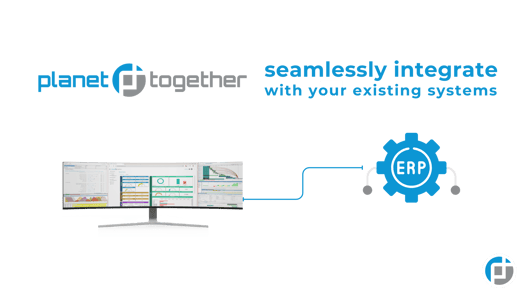Workforce Management Integration with Scheduling Systems in Packaging Manufacturing
Unlock efficiency in packaging manufacturing with seamless integration of workforce management and scheduling systems. Optimize resources and reduce...
Unlock efficiency by integrating PlanetTogether APS with ERP systems for automated, optimized purchasing in chemical manufacturing.

In chemical manufacturing, purchasing managers stand at the crossroads of operational efficiency, cost control, and supplier management. With volatile raw material markets, strict regulatory environments, and increasing pressure for sustainability, the purchasing function can no longer afford to operate in silos. Integrating processes and automation has become a critical strategy, and advanced planning and scheduling (APS) systems like PlanetTogether, when integrated with enterprise resource planning (ERP) systems such as SAP, Oracle, Microsoft, Kinaxis, or Aveva, offer purchasing managers a powerful way to orchestrate seamless, data-driven decisions.
This blog explores how integrating processes and automation reshapes chemical purchasing, the specific gains achievable through APS-ERP integration, and why purchasing managers in chemical manufacturing must embrace these technologies to remain competitive.
Chemical manufacturing is unlike many other industries: it deals with highly specialized materials, sensitive lead times, stringent quality requirements, and fluctuating demand linked to global supply chains. A purchasing manager must balance:
Supplier performance (on-time delivery, cost, quality)
Inventory availability (avoiding both shortages and overstocking)
Regulatory compliance (environmental, safety, and quality regulations)
Cost control (mitigating raw material price fluctuations)
Without integrated systems, purchasing decisions often rely on fragmented data, manual processes, and reactive strategies. This leads to delays, missed opportunities for cost savings, and an inability to respond quickly to production or market changes.

Integrating PlanetTogether APS with ERP systems like SAP, Oracle, Microsoft, Kinaxis, or Aveva creates a single source of truth across purchasing, production, and supply chain operations. APS specializes in real-time scheduling and optimization, while ERP systems provide the master data, transactional records, and financial controls.
Together, they create a closed-loop ecosystem where automation drives purchasing efficiencies. Here’s how:
Real-Time Demand Signals Drive Purchasing Precision
Traditionally, purchasing operates on static forecasts and long-range procurement plans. However, in a chemical plant where batch production may shift daily, these static plans can become outdated almost immediately.
By integrating PlanetTogether APS, purchasing managers gain real-time visibility into production schedules. When the APS system updates a batch schedule, changes in raw material needs are immediately reflected. Automated triggers in the ERP system can:
Generate purchase requisitions or orders
Alert suppliers to upcoming needs
Adjust delivery schedules dynamically
This reduces manual intervention, minimizes shortages, and cuts excess ordering, aligning purchasing directly with actual production.
Automation Frees Purchasing Teams from Repetitive Tasks
Repetitive tasks—like updating spreadsheets, matching POs to production runs, or chasing approvals—consume purchasing teams’ time. With APS-ERP integration, automation takes over routine tasks, including:
Auto-generating purchase orders based on real-time material requirements
Automating supplier communications for delivery confirmations and changes
Linking purchase orders to production batches for full traceability
This frees purchasing teams to focus on strategic sourcing, supplier negotiations, and innovation partnerships, rather than routine clerical work.
Optimized Supplier Collaboration and Lead Time Management
In chemical manufacturing, lead times matter. Some materials require weeks or even months of lead time, and disruptions can have cascading effects on production.
With integrated APS and ERP systems, purchasing managers can:
Provide suppliers with longer-term visibility into upcoming needs, improving their readiness
Model “what-if” scenarios within PlanetTogether to see how supplier delays affect production and adjust orders accordingly
Optimize order frequency and lot sizes based on dynamic production demand, balancing cost and delivery reliability
This collaborative, automated approach strengthens supplier relationships and improves supply chain resilience.
Better Cost Control and Risk Mitigation
APS-ERP integration allows purchasing managers to make data-driven decisions about when and how much to buy. For example, if PlanetTogether identifies a shift to higher-demand products, the purchasing system can:
Secure critical raw materials early to avoid price spikes
Negotiate volume discounts with suppliers ahead of demand increases
Reduce rush orders and premium freight costs by planning purchases proactively
By integrating automation into the purchasing process, companies avoid last-minute, reactive buying and gain greater control over costs.
While the benefits are clear, successful integration between PlanetTogether APS and ERP systems like SAP, Oracle, Microsoft, Kinaxis, or Aveva requires thoughtful implementation. Purchasing managers should collaborate closely with IT, production planning, and supply chain teams to ensure:
Clear data flows: Ensure master data (materials, suppliers, lead times) is accurate and synchronized between APS and ERP systems.
Defined triggers and automation rules: Set up business rules for when purchase requisitions are auto-generated, when manual approvals are required, and how supplier communications are automated.
Cross-functional alignment: Integrate purchasing processes with production, inventory, and logistics teams to ensure seamless handoffs and shared visibility.
Change management and training: Equip purchasing teams with the tools and knowledge to transition from manual to automated, data-driven workflows.
For purchasing managers in chemical manufacturing, integrating processes and automation through PlanetTogether APS and ERP systems like SAP, Oracle, Microsoft, Kinaxis, or Aveva isn’t just a technology upgrade—it’s a fundamental shift in how the purchasing function operates. By uniting real-time production insights with automated purchasing workflows, companies can:
Enhance purchasing precision
Improve supplier collaboration
Control costs and mitigate risks
Free teams for strategic innovation
As the industry faces increasing complexity, automation and integration provide a clear path to staying ahead of the competition.
It’s time for purchasing leaders to move beyond manual processes and embrace the integrated, automated future. Are you ready to take your manufacturing operations to the next level? Contact us today to learn more about how PlanetTogether can help you achieve your goals and drive success in your industry.
Unlock efficiency in packaging manufacturing with seamless integration of workforce management and scheduling systems. Optimize resources and reduce...
Optimize manufacturing with PlanetTogether integration. Achieve real-time control and efficiency. Explore ERP, SCM, and MES synergy.
Streamline purchasing in packaging manufacturing with automation. Discover how integrating PlanetTogether and ERP systems boosts efficiency,...
Be the first to know about new B2B SaaS Marketing insights to build or refine your marketing function with the tools and knowledge of today’s industry.